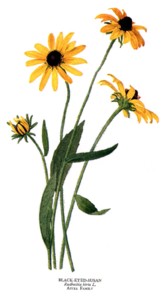Rustic Rudbeckia
By Audrey Stallsmith

All in the Downs the fleet was moor’d,
The streamers waving in the wind,
When black-eyed Susan came aboard;
‘O! where shall I my true-love find?
Tell me, ye jovial sailors, tell me true
If my sweet William sails among the crew.’
"Black-eyed Susan" by John Gay
Among the few plants still blooming in my garden at this time of year, along with dahlias and mums, are the rudbeckias. Their golds, browns, and rusts coordinate, in fact, very well with autumn leaves.
Strangely enough, the native American wildflower known as black-eyed Susan derived its common name from the British poem above. (Perhaps Dianthus barbatus, better known as Sweet William, did as well!)
The British do seem to have appreciated rudbeckia first, as it became a popular garden flower there before making its way back "across the pond" to the land of its origins. To add insult to injury, the all-American plant derived its Latin name from Olaf Rudbeck, a Swedish botanist and professor of Linneaus.
But we can be consoled by the fact that the plant still flourishes in its land of origin! Although native to the sunny plains, it moved east in hay seed, and now grows wild in most of North America.
Due to its gold and black colors, matching the coat of arms of Lord Baltimore, the black-eyed Susan even became Maryland's state flower. So winners of the Preakness are rewarded, not with a horseshoe of roses, but of rudbeckias.
Rudbeckia laciniata ("lacerated" black-eyed Susan) seems to have been "discovered" first, probably because it was too large to overlook! It can grow up to twelve feet high, though a more common height is seven feet. The heirloom type known as Golden Glow is actually laciniata flore-pleno--or a double-flowered form of the giant.
But the shorter black-eyed Susan so many of us see in bloom along summer roadsides is Rudbeckia hirta, called "hairy" for its rough stems and leaves. Most modern garden rudbeckias, including the new cherry type that came out this year, were derived from this wilding.
But the larger gloriosa daisies, though hirta varieties as well, have twice the normal number of chromosones. They were created by treating plants with radiation or colchicine--a chemical originally derived from the autumn crocus, colchicum.
The ubiquitous and free-flowering Goldstrum is, however, a type of Rudbeckia fulgida ("shining" black-eyed Susan). But it makes up for its smaller blooms with the almost overwhelming number of them.
Although some rudbeckias are called annuals or biennials, most will return every year due to the vigor of their self-sowing. The plant stands for "justice" in the Language of Flowers, perhaps in hopes that justice will be as dependable!
Rudbeckia has also been known as brown-eyed Susan, brown Betty, golden Jerusalem, and Poorland daisy. (I suspect that middle-Eastern nickname might derive from its resemblance to the blooms of Jerusalem artichoke.) Rudbeckia has even been called coneflower at times, due to its close relationship with the echinaceas.
In fact, herbalist James Duke reports in The Green Pharmacy that he "suspected for years. . .black-eyed Susan might be as strong an immune stimulant as the various species of echinacea." His hunch "was confirmed by a research report saying that root extracts [of rudbeckia] indeed do a better job of stimulating the immune system than do extracts of echinacea." So he recommends the plant for AIDS patients.
As an astringent and diuretic, it was also used by Native Americans to treat sores and snakebite, dropsy, earaches, diarrhea, and various other maladies. We gardeners love it, however, because it is so easy and rustic looking and, well, just bloomin' good!
Rudbeckia hirta image is from National Geographic, courtesy of the Southwest School of Botanical Medicine.








